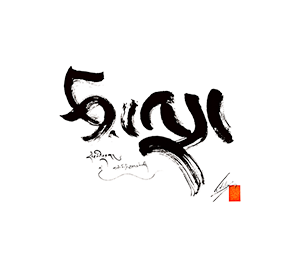Sina Joos at the 2019 Tathāgatagarbha Symposium
< Media
Abstract from the Author
Tā ra nā tha (1575-1635) is considered second in importance to Dol po pa Shes rab rgyal mtshan (1292-1361) regarding the proclamation of gzhan stong and the number of his authored works. He clarified and expanded Dol po pa’s exegesis of gzhan stong unlike anyone before him. Tā ra nā tha’s dBu ma theg mchog covers a variety of topics relevant to the gzhan stong view, including essential Mahāyāna concepts that range from Yogācāra to Madhyamaka and from the Laṅkāvatārasūtra to the Tathāgatagarbhasūtra.
In the third chapter of the dBu ma theg mchog, Tā ra nā tha gives a detailed presentation of buddha-nature, which he equates to the dharmadhātu and suchness. The Ratnagotravibhāga is quoted extensively and exclusively in this chapter, while the Mahāyānasūtrālaṁkāra is quoted throughout the dBu ma theg mchog. This chapter is divided into nine main points, and the fourth point alone, referred to as “endowed with all aspects,” is illustrated by six verses from the Ratnagotravibhāga. However, also most of the other points (permanence, pervasion, wakefulness, unmixed/untainted and union) are attested by direct quotes from the Ratnagotravibhāga.
This study will examine the ways in which Tā ra nā tha utilizes the Ratnagotravibhāga in his dBu ma theg mchog to assert his understanding of buddha-nature as gzhan stong. It will be based on the root text as well as the commentary written by Tā ra nā tha’s disciple Ye shes rgya mtsho according to direct yearly instructions from Tā ra nā tha himself. As Tā ra nā tha is known to have expanded and systemized Dol po pa’s view, Tā ra nā tha’s position will also be compared to that of Dol po pa.Sources Mentioned
The Mahāparinirvāṇasūtra is one of the main scriptural sources for buddha-nature in China and Tibet. Set around the time of Buddha's passing or Mahāparinirvāṇa, the sūtra contains teachings on buddha-nature equating it with the dharmakāya—that is, the complete enlightenment of a buddha. It also asserts that all sentient beings possess this nature as the buddhadhātu, or buddha-element, which thus acts as a cause, seed, or potential for all beings to attain enlightenment. Furthermore, the sūtra includes some salient features related to this concept, such as the single vehicle and the notion that the dharmakāya is endowed with the four pāramitās of permanence, bliss, purity, and a self.
Secondary Publications Mentioned
In particular she does this with reference to the only surviving Indian commentary on the Tathagatagarbha doctrine, the Ratnagotravibhaga. This text addresses itself directly to the issue of how to relate the doctrine of emptiness (the illusory nature of the world) to that of the truly existing, changeless Absolute (the Buddha Nature).
This is the first work by a Western writer to present an analysis of the Shentong tradition based on previously untranslated sources. The Shentong view rests on meditative experience that is inaccessible to the conceptualizing mind. It is deeply rooted in the sutra tradition of Indian Buddhism and is central to an understanding of the Mahamudra and Dzogchen traditions and Tantric practice among the Kagyupas and Nyingmapas.
(Source: SUNY Press)People Mentioned
About the video
| Featuring | Sina Joos |
|---|---|
| Creator | Universität Wien, Tsadra Foundation |
| Event | Tathāgatagarbha Across Asia (18 July 2019, University of Vienna, Austria) |
| Related Website | Buddha-Nature Project |
| Video Web Location | Tathāgatagarbha Across Asia |
| Creation Date | 18 July 2019 |
| Citation | Joos, Sina. "The Role of the Ratnagotravibhāga in Tā ra nā tha’s dBu ma theg mchog." Paper presented at the University of Vienna Symposium, Tathāgatagarbha Across Asia, Vienna, Austria, July 2019. Video, 40:46. https://www.youtube.com/watch?v=kxn5XgPGnSU. |
